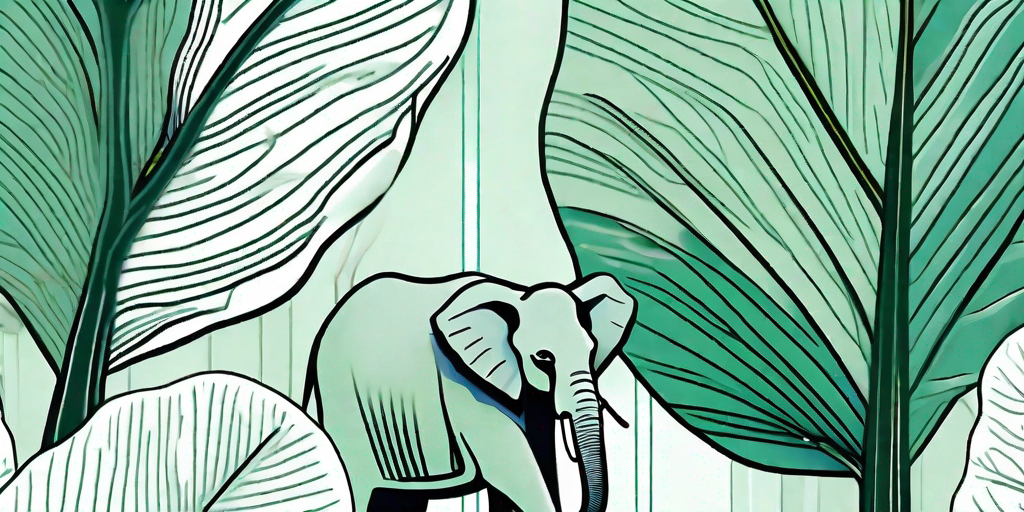
Ah, the Elephant Ear Plant. It's not just a plant, it's a statement. A declaration of your commitment to the green thumb life. But how does one go about growing this lush, leafy specimen? Fear not, dear reader, for we have the answers you seek.
The Basics of the Elephant Ear Plant
What is an Elephant Ear Plant?
Before we dive into the nitty-gritty of growing one, let's first understand what an Elephant Ear Plant is. The Elephant Ear Plant, or Colocasia esculenta, is a tropical plant known for its large, heart-shaped leaves. It gets its name from the resemblance these leaves bear to an elephant's ears. But don't worry, no elephants were harmed in the making of this plant.
Native to Southeast Asia, the Elephant Ear Plant is a perennial that can reach up to 8 feet in height. It's a showstopper in any garden, but it's not just about looks. This plant is also known for its edible corms, which are a staple in many tropical cuisines.
Why Grow an Elephant Ear Plant?
Aside from its dramatic aesthetic appeal, the Elephant Ear Plant is also relatively easy to grow, making it a favorite among both novice and experienced gardeners. It's also a great way to add a touch of the tropics to your garden, even if you're stuck in the middle of suburbia.
Plus, who wouldn't want a plant that doubles as a conversation starter? "Oh, that giant leafy plant over there? That's just my Elephant Ear Plant. No big deal."
How to Grow an Elephant Ear Plant
Choosing the Right Location
Elephant Ear Plants are divas, and they need their space. They prefer a location with partial to full sun and well-drained soil. They're also not fans of the cold, so if you live in a cooler climate, you might want to consider growing your Elephant Ear Plant in a pot so you can bring it indoors during the winter.
Remember, these plants can get quite large, so make sure to give them plenty of room to spread out. Nobody likes a cramped Elephant Ear Plant.
Planting the Corms
Elephant Ear Plants are grown from corms, which are kind of like bulbs but not quite. To plant your corms, dig a hole about 4 inches deep and place the corm with the pointed side facing up. Cover with soil and water thoroughly.
Patience is key here. It can take a few weeks for the corms to sprout, but once they do, you'll be rewarded with a rapidly growing plant that's sure to be the envy of all your neighbors.
Caring for Your Elephant Ear Plant
Watering and Fertilizing
Elephant Ear Plants are thirsty creatures. They like their soil to be consistently moist, but not waterlogged. A good rule of thumb is to water your plant when the top inch of soil feels dry to the touch.
As for fertilizing, a slow-release fertilizer applied in the spring and again in the summer should do the trick. Remember, Elephant Ear Plants are heavy feeders, so don't skimp on the nutrients.
Winterizing Your Plant
If you live in a region where the temperature drops below 50 degrees Fahrenheit, you'll need to winterize your Elephant Ear Plant. This involves digging up the corms, letting them dry for a few days, and then storing them in a cool, dry place until spring.
Yes, it's a bit of work, but trust us, it's worth it. Come spring, your Elephant Ear Plant will be ready to make its grand reappearance, bigger and leafier than ever.
Common Problems and How to Solve Them
Yellowing Leaves
If the leaves of your Elephant Ear Plant are turning yellow, it could be a sign of overwatering. Cut back on the H2O and make sure your plant's soil is well-draining.
Leaf Spot
Leaf spot is a fungal disease that can cause brown spots on the leaves of your Elephant Ear Plant. To prevent this, avoid overhead watering and make sure your plant has plenty of air circulation.
Frequently Asked Questions
- Can I grow an Elephant Ear Plant indoors?
Yes, you can! Just make sure to provide it with plenty of light and keep the soil consistently moist.
- Are Elephant Ear Plants poisonous?
Yes, they can be. The leaves and corms of the Elephant Ear Plant contain calcium oxalate, which can cause irritation if ingested. Keep this plant out of reach of pets and children.
- How fast do Elephant Ear Plants grow?
With the right conditions, Elephant Ear Plants can grow very quickly, often adding a new leaf every week during the growing season.
And there you have it, folks. Everything you need to know about growing an Elephant Ear Plant. Now go forth and add some leafy drama to your garden. You've got this!















